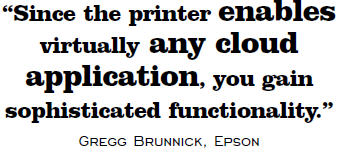POS Evolution Can Boost Receipt-Printer Sales
By Brian Albright, Business Solutions magazine.
Mobile POS solutions and cloud-connected printers can help VARs sell new hardware and services to merchants.

Functionality such as color printing and network interfaces have helped enable new applications for receipt printers and lift those devices, at least partly, out of their status as commodity peripherals. Now, the advent of cloud computing solutions, electronic-receipt options, and (especially) mobile point of sale (POS) systems are causing a significant technological shift for printers that equates to sales opportunities for resellers.
Mobile POS, in particular, is having a direct impact on what printers are deployed and how they are configured. “Whether or not you view mobility as a threat or an opportunity depends on how you see the value of the receipt, and if you can imagine an evolution of printed receipts that work with the mobile environment,” says Jose Basa, director of business development at CognitiveTPG.
Increasingly, merchants are looking for printers that can interface with multiple types of smart devices (including POS terminals, smartphones, and tablets). “The mobile trend offers a huge opportunity for selling receipt printers, and the ability to operate printers through smart devices is critical,” says Gregg Brunnick, director of marketing for Epson America’s business systems division. “The industry’s newest printers enable retailers to seamlessly integrate mobile POS solutions with no drivers to install, and they provide seamless communication to smart devices anywhere in the store.”
New Android- and iOS-based mobile phones and tablets do not interface with receipt printers in the same way as a PC or a traditional POS station. These mobile devices usually require an app to communicate with the printer, and do not typically have inherent printer support. Printer manufacturers have responded by developing their own SDKs (software development kits) and APIs (application programming interfaces) to provide this functionality. IOS devices also require a different approach to wireless connectivity, which manufacturers have adapted to by either using Apple’s protocol for Bluetooth or opting for a Wi-Fi connection as an alternative.
Mobility presents another challenge, as well, since mobile solutions offer the option of using electronic receipts, rather than traditional paper ones. For the time being, though, most customers prefer having a paper receipt because it makes verifying purchases and returning items easier in most scenarios. “At some point in the future there will be a significant conversion, but right now we’re seeing too many concerns about customer privacy, store theft, and slower POS transactions and returns,” Brunnick says. “The newest generation of smart solutions enables cloud applications that offer digital receipts, but still offer a physical receipt option.”

According to the vendors interviewed for this story, cloud-based POS solutions are another trend impacting the receipt-printer space. “The hottest next-generation smart solutions are ahead of the curve when it comes to cloud POS, as these printers have the ability to directly connect with the cloud,” Brunnick says. “The most sophisticated versions provide essential backup if the Internet connection is lost by storing the transaction data and then transferring that data back to the cloud when the connection is back up and running.”
Cloud connectivity also enables much greater POS data visibility to the merchant with a lower up-front cost, but the structure of these deployments can vary based on the clients’ needs and their tolerance for risk or some data latency at the terminal. Some cloud deployments utilize thin-client POS terminals, while others include some level of transaction caching at the terminal or a local server to safeguard against network connectivity issues. The presence of multiple peripherals (not just printers, but scales, scanners, cash drawers, security equipment, etc.) can also affect the structure of a cloud-based POS system, since not all of these items can connect directly to the cloud.
“Putting all your data on the cloud can be scary, and yet we know the benefits are real and justifiable,” Basa says. “For instance, cloud-based data allows for multiple users to dissect the data, which heightens visibility across the organization. As with anything else, this process can be significantly beneficial or just a data dump, depending on the infrastructure of the company.”
Printers Create Services, Mobile POS Opportunities
There are changes under way in the printer space, including a lot of technology innovations. Resellers need to make sure they are promoting their printers to their fullest extent and explaining the role they play in enabling an advanced POS solution. After all, the receipt is still an ideal in-store coupon, advertising, and survey tool. “In comparison to the cost of freestanding insert coupons and advertisements, receipt paper is cheap. Why wouldn’t you consider leveraging it as a marketing tool?” Basa says. “The message can be delivered to current customers to increase repeat purchases. Retailers who are not using the register tape as a marketing tool are missing an easy opportunity to interact with their customers and drive repeat traffic.”
VARs should also fully leverage the cloud capabilities of these printers. Connecting the printer to the cloud doesn’t just allow users to print from any mobile device or phone without worrying about printer drivers; doing so also provides additional flexibility for the merchant when setting up their hardware. With the printer connected directly to the cloud application rather than tethered to a specific POS terminal, VARs can help their clients implement solutions that, for example, allow multiple mobile POS clients to connect to a single printer.
“With the newest POS solutions, the sky is truly the limit, and VARs can really take advantage of upselling these services with a simple printer upgrade,” Brunnick says. “Since the printer enables virtually any cloud application, you gain sophisticated functionality, such as data analytics, couponing, loyalty, and digital receipts. In addition, some of these cloud applications provide additional, ongoing revenue streams to VARs who sell and support their services.”
Printers can now play an even greater role in expanding the functionality of POS applications and generating new opportunities for VARs to provide consulting and other services that not only create revenue, but also reinforce the VAR/client relationship. “We are witnessing the evolution of the receipt printer in terms of the paper it prints on and the environment it prints in,” Basa says. “Receipt printers that are able to accessorize, modify for certain environments, configure to different paper applications, and adapt to the customers’ distinctive application will give resellers a true value proposition.”
